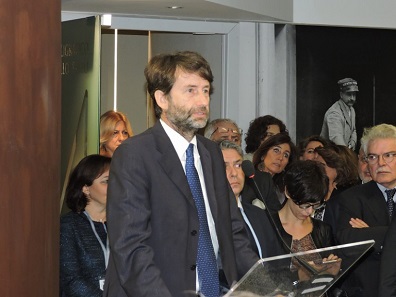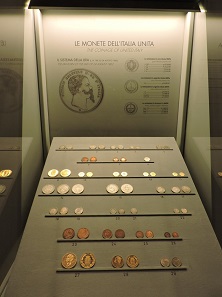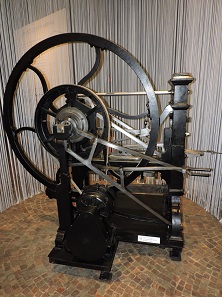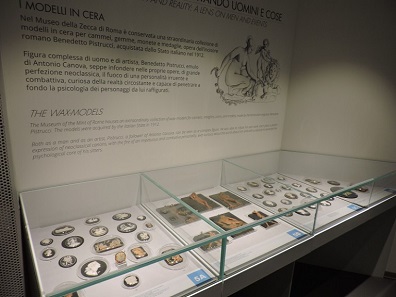by Roberto Ganganelli and Björn Schöpe
translated by Annika Backe
May 18, 2017 – On October 25, 2016 the new museum of the Italian Mint (Istituto Poligrafico e Zecca dello Stato, IPZS) celebrated its reopening. The exhibition is located in the IPZS manufacturing complex in Via Salaria, Rome and houses more than 20,000 objects – coins, medals, dies, wax models, and much more. The highlights of the collections are the masterpieces made by Benedetto Pistrucci, who designed the legendary gold sovereigns for Great Britain.
The Minister of Cultural Heritage and Activities and Tourism, Dario Franceschini, held a speech at the official inauguration. Photo: Roberto Ganganelli.
Before the official inauguration, the President of the Italian Republic, Sergio Mattarella had been given a private tour. He applauded the exhibition and the cultural message the museum conveyed to its visitors. The exhibition had been designed by Professor Silvana Balbi de Caro and architect Giovanni Bulian.
Archaeological remains were skillfully integrated into the exhibition on two floors. Photo: Roberto Ganganelli.
Integrating what has survived of a Roman mausoleum, the exhibition not only emphasizes the historical continuity: On two floors, the museum shows how IPZS had incorporated the Mint of the Papal State and, at the same time, expanded it for the newly founded Italian State. However, the chronological part starts with the initial stage of minting in Italy in the 9th century AD and reaches as far as the euro.
The oeuvre of Orlando Paladino Orlandini, among others, represents the Italian medallic art of the 20th century. Photo: Roberto Ganganelli.
IPZS Managing Director, Paolo Aielli pointed out that the new exhibition “intends to upgrade a legacy that had been lost due to ill-considered willingness to make savings, a lack of consideration for the care of the past or, even worse, pure negligence.” Some readers may remember: The former museum was located in the Ministry of Finance and had not been open to visitors for years.
The workplace of a die cutter. Photo: Roberto Ganganelli.
It took less than a year from the first ideas on a possible design to the museum’s inauguration of the museum, Aielli emphasized. Located in one of the most modern IPZS facilities now, the museum may well move again in two to three years. It is planned to be finally situated in the historical buildings in Via Principe Umberto, already home to the famous IPZS medalist school, the Scuola dell’arte della Medaglia.
“The Coins of Unified Italy”, one of the thematic showcases, illustrates how the lira evolved between the 19th and the 20th century. Photo: Roberto Ganganelli.
Showcases focus on the Marenghi and the coins after the unification of Italy, trial strikes and projects initiated by Vittorio Emanuele III, the first lira coins of the Republic, and much more.
This is rounded up by thematic groups, illustrating, for instance, the iconography of the coins of the 1920s (“Coins and Propaganda”) or “Faces of Italy between Kingdom and Republic”.
One of the historical minting machines of the Royal Mint, on display in the new exhibition. Photo: Roberto Ganganelli.
The exhibition also presents numerous technical exhibits the mint had carefully preserved, and which are now, at least partly, shown to a broad audience.
Wax models for medals and plaques by famous Benedetto Pistrucci are assembled in this showcase. Photo: Roberto Ganganelli.
A collection of wax and plaster models by Benedetto Pistrucci stands out. His designs of Saint George killing the dragon have featured on the British sovereigns since 1816. But also contemporary designs are presented.
It was clear to see that the Undersecretary of Economy and Finances, Paolo Baretta enjoyed the workplace equipment when he kneaded a model for a medal at the new museum of the Mint. Photo: Roberto Ganganelli.
Last but not least, the young visitors can use their hands and strike their own commemorative medals in workshops. The Undersecretary of Economy and Finances, Pier Paolo Baretta was also enthusiastic about this practical exercise, when, on the occasion of the opening ceremony, he made his own medal from clay.
In addition to book publications presenting the museum, the modern integration into the digital media deserves special mentioning. The new website of the Mint museum presents a comprehensive online exhibition. There, you can find numerous exhibits in good pictures, with a lot of detailed information.
You can get fine insight into the exhibition as well as the minting work of past times through a video, which you will find at the bottom of this article on the page of Il Giornale della Numismatica. (In this article, you will also see a few objects of the exhibition as well as historical pictures of the Mint.)
This is the beautiful Museo della Zecca di Roma website (unfortunately, it is in Italian only).
You can browse the online collection here.
And if you are interested in new Italian strikings, please have a look at the IPZS webpage.
You can find more about the school of medal-making, the Scuola dell’Arte della Medaglia, here.











